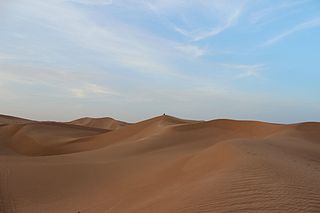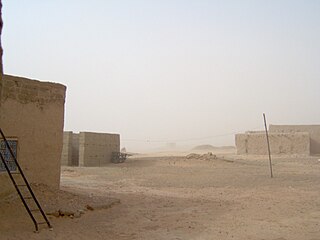The erg is a unit of energy equal to 10−7 joules. It originated in the Centimetre–gram–second system of units (CGS). It has the symbol erg. The erg is not an SI unit. Its name is derived from ergon (ἔργον), a Greek word meaning 'work' or 'task'.

Ubykh is an extinct Northwest Caucasian language once spoken by the Ubykh people, a subgroup of Circassians who originally inhabited the eastern coast of the Black Sea before being deported en masse to the Ottoman Empire in the Circassian genocide.
Mam is a Mayan language spoken by about half a million Mam people in the Guatemalan departments of Quetzaltenango, Huehuetenango, San Marcos, and Retalhuleu, and the Mexican states of Campeche and Chiapas. Thousands more make up a Mam diaspora throughout the United States and Mexico, with notable populations living in Oakland, California and Washington, D.C. The most extensive Mam grammar is Nora C. England's A grammar of Mam, a Mayan language (1983), which is based on the San Ildefonso Ixtahuacán dialect of Huehuetenango Department.
Lezgin, also called Lezgi, is a Northeast Caucasian language. It is spoken by the Lezgins, who live in southern Dagestan (Russia); northern Azerbaijan; and to a much lesser degree Turkmenistan; Uzbekistan; Kazakhstan; Turkey, and other countries. It is a much-written literary language and an official language of Dagestan. It is classified as "vulnerable" by UNESCO's Atlas of the World's Languages in Danger.

hERG is a gene that codes for a protein known as Kv11.1, the alpha subunit of a potassium ion channel. This ion channel is best known for its contribution to the electrical activity of the heart: the hERG channel mediates the repolarizing IKr current in the cardiac action potential, which helps coordinate the heart's beating.

Talysh is a Northwestern Iranian language spoken in the northern regions of the Iranian provinces of Gilan and Ardabil and the southern regions of the Republic of Azerbaijan by around 500,000-800,000 people. Talysh language is closely related to the Tati language. It includes many dialects usually divided into three main clusters: Northern, Central (Iran) and Southern (Iran). Talysh is partially, but not fully, intelligible with Persian. Talysh is classified as "vulnerable" by UNESCO's Atlas of the World's Languages in Danger.
Erg Mountain Provincial Park is a provincial park in British Columbia, Canada.
Futunan or Futunian is the Polynesian language spoken on Futuna. The term East-Futunan is also used to distinguish it from the related West Futunan (Futuna-Aniwan) spoken on the outlier islands of Futuna and Aniwa in Vanuatu.

The Grand Erg Occidental, is the second largest erg in northern Algeria after the Grand Erg Oriental. It covers an area of approximately 78,000 square kilometres (30,000 sq mi). The sand dunes in the erg are formed by the wind, and can be up to 120 metres (390 ft) high. Certain crescent-shaped dunes, known as barchans, are actually mobile; the wind can push these dunes as much as 20 to 30 m (65–100 ft) in one year.
Coeur d'Alene is a Salishan language. It was spoken by only two of the 80 individuals in the Coeur d'Alene Tribe on the Coeur d'Alene Reservation in northern Idaho, United States in 1999. It is considered an endangered language. However, as of 2014, two elders in their 90s remain who grew up with Cœur d'Alène as their first language, and the use of the language is spreading among all age groups.
The Coeur d'Alene Names-Places Project visits geographic sites on the reservation recording video, audio, and still photos of Tribal elders who describe the site in both English and Coeur d'Alene languages.

Khamlia is small village located on the edge of sand dunes of Erg Chebbi in southeast Morocco near the Algerian border. The village is also called the southern gateway to the Sahara.
Takoujt village is located on the bottom of Erg Chebbi, a Saharan erg in southeast Morocco near the Algerian border.
Tanamoust is located at the bottom of Erg Chebbi, a Saharan erg in southeast Morocco near the Algerian border.
Hassilabied is a village in the Sahara Desert in Morocco, 5 km north of Merzouga. Most people are here to take a camel safari into the dunes of Erg Chebbi, and to get a taste of remote (tourism-influenced) Berber life.

The Nias language is an Austronesian language spoken on Nias Island and the Batu Islands off the west coast of Sumatra in Indonesia. It is known as Li Niha by its native speakers. It belongs to the Northwest Sumatra–Barrier Islands subgroup which also includes Mentawai and the Batak languages. It had about 770,000 speakers in 2000. There are three main dialects: northern, central and southern. It is an open-syllable language, which means there are no syllable-final consonants.
Trumai is an endangered language isolate of Brazil. Most Trumai are fluent in languages of wider communication, and children are not learning it well.

The Hawu language is the language of the Savu people of Savu Island in Indonesia and of Raijua Island off the western tip of Savu. Hawu has been referred to by a variety of names such as Havu, Savu, Sabu, Sawu, and is known to outsiders as Savu or Sabu. Hawu belongs to the Malayo-Polynesian branch of the Austronesian language family, and is most closely related to Dhao and the languages of Sumba. Dhao was once considered a dialect of Hawu, but the two languages are not mutually intelligible.
Khroskyabs is a Gyalrongic language of China. It is called Guanyinqiao in Ethnologue after a town in western Sichuan where one dialect of the language is spoken, Thugsrje Chenbo. It has been referred to as Lavrung in previous publications.

Kʼicheʼ, or Quiché, is a Mayan language spoken by the Kʼicheʼ people of the central highlands in Guatemala and Mexico. With over a million speakers, Kʼicheʼ is the second most widely-spoken language in the country, after Spanish. It is one of the most widely-spoken indigenous American languages in Mesoamerica.
The Ly Erg is a fairy from Scottish folklore, particularly associated with the area in and around the Glenmore Forest, part of the present-day Cairngorms National Park. It is dressed as a soldier, distinguishable from a real soldier only by its red right hand, said to be stained with the blood of its victims. While out walking it will stop near water, and by raising its right hand challenge passersby to fight. But anyone who engages in combat with the Ly Erg will be dead within a fortnight, win or lose.